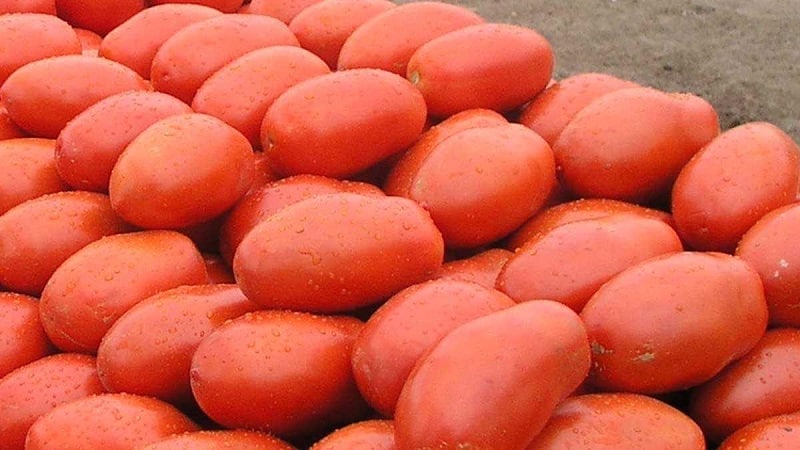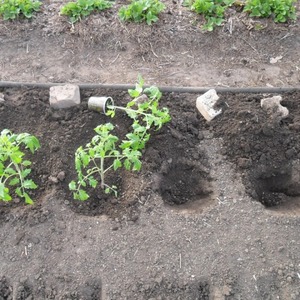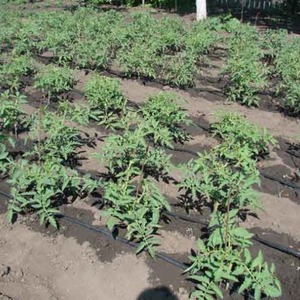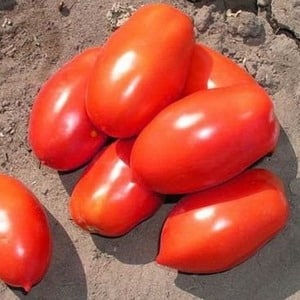The legendary hybrid - the "Inkas" tomato: why it is so loved in different countries, and why you will like it
The Incas tomato, thanks to Dutch selection, has confidently taken root not only in Russian garden beds, but also in neighboring countries. Its popularity is due to its ability to quickly adapt to weather conditions and the excellent taste of the fruit.
Few varieties can boast of a high fruiting rate at early ripening periods. This tomato combines all the necessary qualities for successful breeding and confidently continues to win new fans with its unique characteristics.
Description of the variety
More than 20 years ago, Dutch breeders developed another hybrid - the Incas F1 tomato. For many years, it has been grown not only by amateur summer residents, but also by agricultural and technical enterprises in Russia, Moldova and Ukraine.
Distinctive features
Bush determinant, height reaches 1 m, can be completed independently. The stem is powerful, the leaves are medium-sized, dark green.
The variety is early ripening, 95-100 days pass from the moment of sowing to full ripening. It tolerates short-term sharp drops in temperature, prolonged rains and drought.
The yield is high, 3 kg is harvested from one seedling, provided that 6-7 plants are planted per 1 square meter. m.
The culture requires mandatory pinching and tying. To increase fruiting, plants are formed into several stems.
It has good resistance to fungal diseases and tobacco mosaic.Recommended for cultivation in open ground and greenhouse conditions.
Fruit characteristics
The average weight of the fruit reaches 90-100 g, they have an elongated pepper-shaped shape and a bright red color. The tomatoes taste sweet with a slight sourness, the flesh is juicy and tender. The skin is elastic, dense, and does not crack.
The fruits tolerate prolonged exposure to sunlight and are not susceptible to burns.
The purpose is universal: they are consumed fresh, used for pickling, marinades, whole-fruit canning and processing into tomato products (juice, lecho, paste, ketchup, adjika). Excellent for harvesting for the winter without the skin.
Ripe vegetables are subject to long-term storage and long-term transportation without loss of external and taste qualities.
The photo below shows Inkas f1 tomatoes.

How to grow seedlings
Sowing seeds for seedlings begins two months before planting in the ground, usually in the last ten days of March.
Seed preparation
Before sowing, the seeds are carefully inspected for visible defects: Suitable grains must be light in color, without bending or visible damage.
The germination of grains is checked by immersing them in a saline solution, dissolving one teaspoon of salt in a glass of water. Those seeds that float to the surface after 10 minutes are empty and are not suitable for sowing.
There is no need to disinfect the planting material; the manufacturer treats them with thiram.
Reference. Thiram is a contact fungicide, effective against fusarium, anthracnose, and rotting of roots and stems. Has a protective effect from 4 to 6 weeks.
To improve germination, seeds are germinated for several days at a temperature of 24 degrees.They are wrapped in gauze, slightly moistened and left in a warm place until the first sprouts appear.
Container and soil
The soil is prepared from garden soil, peat and wood ash with the addition of humus. For lightness, add a little washed river sand. After thoroughly mixing all the components, the mixture is poured with a hot solution of pink potassium permanganate.
Planting containers are disposable plastic cups, which are filled two-thirds with prepared soil. Incomplete filling of the cups makes it possible to later add soil as the seedlings grow, thereby providing them with additional nutrients.
Sowing seedlings
Seeds are sown in disposable plastic containers to a depth of 2 cm. The sown containers are immediately placed on a bright windowsill. The optimal temperature for grain germination is 23-24 degrees. After sowing, lightly moisten the soil with a spray bottle.
Growing and care
When the first shoots appear, water lightly along the edge of the containers with a regular tablespoon of warm, settled water. After watering, the soil is loosened, ensuring better penetration of oxygen to the young roots. Daylight hours are required for 12-13 hours. If there is insufficient natural light, add phytolamps.
When two true leaves appear, the seedlings are picked, planted in larger containers than the previous ones. Despite the picking, this variety of tomatoes is prone to stretching, but picking is necessary to strengthen the root system.
Two weeks before planting in the ground seedlings begin to harden, taking it out into the open air for one hour. Gradually, the time spent on the street is increased to 12 hours.At night, the seedlings must be brought into a room where the air temperature is at least 13 degrees.
How to grow tomatoes
The seedlings are ready for transplanting in mid-May in greenhouse conditions, and in open ground at the end of May. By this time, at least 5-7 true leaves and already fully formed strong roots appear on the bushes.
Landing
 The soil for tomatoes is prepared in the fall. Organic matter is added to it, for example, peat, rotted manure or compost in a ratio of 5 kg per 1 sq. m. Organics can be replaced with mineral fertilizers. After this, the soil is dug up and left until spring.
The soil for tomatoes is prepared in the fall. Organic matter is added to it, for example, peat, rotted manure or compost in a ratio of 5 kg per 1 sq. m. Organics can be replaced with mineral fertilizers. After this, the soil is dug up and left until spring.
In the spring, a nutrient mixture consisting of 1 kg of chicken manure and 1.5 kg of wood ash is added again. Dig carefully, removing weeds with roots.
Compost is a natural fertilizer containing useful substances necessary for the full growth of tomatoes. Fertilizer attracts earthworms, which improves the soil structure.
The beds for tomatoes are chosen on the sunny side, protected from drafts. The seedlings are transplanted in the evening or in cloudy weather into shallow holes, which are first filled with water.
If the seedlings are very elongated at home, they are laid horizontally. If the height of the bushes allows them to remain upright, they are planted like any other seedlings.
To strengthen the roots, when replanting, remove all the lower leaves, leaving 3-4 leaves.
Planting pattern: 30-40 cm – distance between seedlings, 50-60 cm – row spacing. For 1 sq. m place 7-8 plants.
Further care for the Incas F1 tomato
The crop needs moderate watering with warm, settled water no more than twice a week. On hot days, the number of waterings increases up to three times. After watering, the soil is loosened and hilled up. To retain moisture in the beds for longer, they are mulched with peat, straw or weeds. When weeds rot, they saturate the crop with useful substances. Water strictly at the root, without getting on the leaves.
The first fertilizing is applied two weeks after transplantation. Fertilize with mullein infusion in a ratio of 1:10. Add one tablespoon of nitrophoska to the resulting solution. Under each bush, apply 0.5 liters of fertilizer.
The second fertilizing is applied during fruit formation. Feed with mineral fertilizer, dissolving 60 g of nitrophoska in 10 liters of water. Apply 1 liter of fertilizer to each bush.
The third time is fed 20 days before the fruit ripens. The fertilizer is organic: dilute 0.5 liters of bird droppings in 10 liters of water with the addition of one tablespoon of urea. 1.5 liters of fertilizer are applied to each bush.
Reference. Feeding apply strictly at the root, without getting on the leaves.
Features of cultivation and possible difficulties
 Culture requires obligatory stepsons, otherwise useful substances will be spent on the growth of green mass, and not on the formation of fruits.
Culture requires obligatory stepsons, otherwise useful substances will be spent on the growth of green mass, and not on the formation of fruits.
No more than four strong shoots are left on the plant, all others are removed. Side shoots grow constantly and are removed before they reach 3 cm.
First of all, the stepsons under the flower brush are removed.
The pinching procedure is carried out in the morning so that by the evening all the wounds have time to heal.
At the stage of plant formation, wooden or metal supports are installed next to each bush for garters. The support must match the height of the plants.
Fixed bushes receive the required amount of light, and the fruits do not come into contact with wet beds.During the entire season, the garter is carried out at least three times.
Diseases and pests
The hybrid genes contain resistance to fusarium wilt and verticillium wilt. But to development late blight High humidity in the beds can cause this. For prevention purposes, it is necessary to control the level of humidity, as well as remove the lower leaves and treat the plants with Fitosporin and copper sulfate. The products “Fitolavin” and “Ordan” protect not only against fungal, but also against viral diseases.
Pests to watch out for spider mite, aphids, whiteflies and Colorado potato beetles. The habitat of spider mites is greenhouses, so for prevention it is enough to regularly ventilate closed structures. The constant flow of fresh air destroys the usual habitat of the greenhouse mite.
Treating the stems with a soap solution helps prevent aphids, and strong-smelling plants planted next to the tomatoes help against whiteflies.
The Colorado potato beetle is collected by hand, carefully inspecting the bushes from all sides.
As for insecticides, “Kleschevit”, “Quadris” or “Confidor” are used in the fight against parasitic insects. But do not forget that the use of chemicals is possible before flowering begins.
The nuances of growing in open ground and greenhouses
When growing crops in open ground, it is necessary to have covering material on hand, especially if we are talking about regions with a temperate climate. When the air humidity is high and the temperature drops sharply, the pollination process stops, causing the flowers to fall off.
This unfavorable factor will undoubtedly affect the quantitative indicator. In addition, during rains there is a high risk of the spread of fungal infections.
At least once a week it is necessary to remove a couple of leaves under the flower clusters. This technique eliminates the crowding of plants, they are better ventilated and receive the necessary amount of light. To increase productivity, pinch the tops of plants.
Harvesting and application
 The fruits ripen within two months as fruitful branches form. The ripening of vegetables is uniform, starting in mid-July and continuing until the end of August due to extended fruiting. Tomatoes do not have to be picked ripe; unripe vegetables can gain color at room temperature, perfectly retaining their taste properties.
The fruits ripen within two months as fruitful branches form. The ripening of vegetables is uniform, starting in mid-July and continuing until the end of August due to extended fruiting. Tomatoes do not have to be picked ripe; unripe vegetables can gain color at room temperature, perfectly retaining their taste properties.
The purpose of ripe vegetables is universal. They are great for fresh use: they are used to make salads and slices, and are used for a variety of snacks, sandwiches and canapés. The small diameter of the fruit allows you to decorate any dish; the original shape looks good on the holiday table.
Tomatoes are suitable for winter preparation; they make excellent marinades and pickles; small tomatoes are used for whole-fruit canning. They are prepared with other vegetables as an assortment. The sweet taste of tomatoes and their thick skin allow you to dry ripe vegetables.
They do not lose their taste in tomato products, such as juices, pastes, lecho, ketchups, adjika.
Ripe tomatoes can be stored for a long time and can withstand long-term transportation without losing their presentation, taste and aroma.
Advantages and disadvantages
The main advantages of this variety, thanks to which it occupies a leading position:
- early maturation;
- high fruiting rate;
- excellent disease resistance;
- ease of care;
- resistance to sunburn;
- good adaptation to weather conditions;
- delicious fruits;
- extended fruiting;
- amicable maturation;
- universal purpose;
- long-term storage;
- possibility of long-term transportation.
The disadvantages of the species include the fact that these tomatoes:
- require a garter;
- require stepsoning.
Farmer reviews
Gardeners' opinions about the hybrid are only positive. Everyone who grew it on their plots is satisfied with the result and recommends the Dutch culture to every gardener.
Nadezhda, Krasnodar: “The hybrid bushes gained a height of 80 cm. Even the leaves were not visible due to the abundance of creamy fruits. The pulp is juicy and fleshy. Tomatoes are delicious both fresh and canned. Growing them is not difficult, the main thing is to form the bushes correctly and remove the stepsons in a timely manner. The harvest was collected until mid-September.”
Inna, Ryazan region: “I planted it last year for a trial. I didn't expect such an amazing effect. 8-9 elongated fruits were formed on the clusters. They taste sweet and are good for storing for the winter. The tomatoes were not sick. What impressed me most was the friendly return of the harvest.”
Conclusion
Numerous reviews from summer residents leave no doubt about the reliability of the Dutch tomato. A good fruiting rate, high resistance to disease, excellent taste of fruits and simple agricultural technology are the basic rules for gardeners when choosing any crop. After all, everyone wants to get excellent results with minimal time and effort.
The Incas tomato, which is completely unpretentious in care, will definitely reward not only a professional, but also a beginner with a rich harvest.